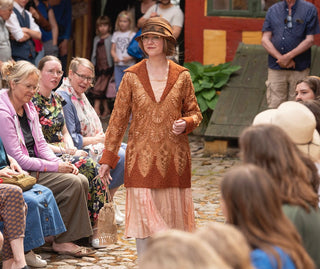A Time of Change and Cultural Liberation
The 1920s—also known as the "Roaring Twenties"—was a vibrant decade marked by dramatic shifts in style and society. Following World War I (1914–1918), many people embraced a spirit of liberation and modernity. Economic prosperity, the rise of jazz, cinema, nightclubs, and new roles for women helped reshape everyday life. As depicted in F. Scott Fitzgerald’s The Great Gatsby, this era was about breaking boundaries—and fashion followed suit.
The fluid, organic shapes of the Art Nouveau era were replaced by the bold geometry and clean lines of the emerging Art Deco style. This transformation influenced everything from architecture and furniture to fashion design.

A classic 1920s everyday look with a dropped waist, cloche hat inspired by military helmets and our 1920's inspired shoe, Yvonne, in black. From my historical fashion show in May. Photo: Tami Meijburg
Women’s Fashion: From Restriction to Rebellion
Women’s fashion in the 1920s reflected the cultural shift toward freedom and self-expression. One of the most iconic styles was the flapper look, also called la garçonne (“the boyish girl” in French). It was a bold departure from the corseted silhouettes of the past.
Key features included:
-
Drop waistlines: Dresses had a low waistline resting on the hips, creating a straight, androgynous silhouette.
-
Shorter hemlines: Knee-length dresses allowed more freedom of movement—scandalous compared to previous eras.
-
Sleeveless designs: Flapper dresses often exposed arms and shoulders, challenging traditional norms.
-
Luxurious fabrics: Evening wear was crafted from silk, velvet, and chiffon, embellished with sequins, beads, and embroidery.
-
Cloche hats: Worn low on the forehead, these hats were inspired by WWI military helmets and often decorated with ribbons or flowers.
-
Short hairstyles: Bobs, finger waves, and even Eton crops became fashionable, paired with more visible makeup like red lipstick and kohl eyeliner.
The flapper dress symbolized rebellion, independence, and a celebration of modern life—especially in nightlife scenes dominated by jazz and Charleston dancing.
 A copper red flapper dress with beaded details, long pearl necklace, and feather headband. From my historical fashion show in May. Photo: Tami Meijburg
A copper red flapper dress with beaded details, long pearl necklace, and feather headband. From my historical fashion show in May. Photo: Tami Meijburg
Working-Class Women’s Fashion
While working-class women didn’t wear elaborate flapper styles on the job, their clothing still reflected the decade’s more relaxed sensibilities.
Typical elements included:
-
Practical dresses made of cotton or wool
-
Hemlines that rose to mid-calf for better mobility
-
Aprons, shawls, knitted cardigans, and thick stockings
-
Simpler hats or headscarves
Their fashion emphasized durability and function, with subtle nods to the trends worn by the upper classes.
Upper-Class Women’s Fashion
For upper-class women, fashion balanced luxury with the modern aesthetic of the time.
Daywear included:
-
Tailored coats and suits
-
Fur stoles
-
Cloche hats and polished gloves
Eveningwear featured:
-
Flapper dresses with intricate beading and embroidery
-
Lavish fabrics like silk and satin
-
Long strands of pearls, feather boas, and art deco jewelry
This style exuded glamour and self-expression.
 Our red Yvonne 1920s pumps displayed on a 1920s dress with 1920s accessories.
Our red Yvonne 1920s pumps displayed on a 1920s dress with 1920s accessories.
1920s Women’s Footwear
Shoes took center stage in the 1920s as hemlines rose and legs—and feet—were on full display.
-
French heels: These stylish heels had a curved silhouette and were typically 1–2 inches high.
-
Mary Janes: The go-to dancing shoe, with a secure strap across the instep. Made of leather or satin in colors from black to red.
-
Bold colors and metallics: Gold, silver, red, and cream were popular choices. Embellishments like embroidery and beading mirrored the glamour of flapper dresses.
 Yvonne is our classic 1920s Mary Jane shoe with a French heel.
Yvonne is our classic 1920s Mary Jane shoe with a French heel.
Men’s Fashion: Elegance Meets Function
While men’s fashion didn’t change as dramatically as women’s, the 1920s still brought about refinement and modern flair.
The standard outfit:
-
Three-piece suits (jacket, vest, trousers) with slimmer cuts
-
Trousers with cuffs and higher waists
-
Single or double-breasted jackets
-
Shirts with detachable collars, often paired with ties or bow ties
-
Two-tone or pinstriped patterns
-
Lighter colors, including white and pastel suits for younger, fashionable men
Working-Class Men’s Fashion
For working men, durability was essential:
-
Wool or tweed trousers
-
Plain shirts and vests
-
Suspenders and flat caps
-
Heavy-duty leather boots
-
Layered clothing in colder months
Upper-Class & Leisurewear for Men
Wealthier men had a wardrobe for every occasion:
-
Formalwear: Tailcoats or tuxedos with patent leather shoes and accessories like cufflinks and pocket watches
-
Leisurewear: Outfits for golf, tennis, or driving included plus-fours, cardigans, cravats, and straw boater hats, often paired with athletic shoes in leather.

1920s menswear look with streamlined silhouette, a relaxed newspaper cap, and brown lace-up boots.
Men’s Footwear in the 1920s
Mens footwear followed the streamlined aesthetic of suits:
-
Oxford shoes: Closed lacing, sleek design—perfect for both business and formal occasions
-
Brogues: Decorative perforations added visual interest
-
Two-tone shoes: Black-and-white or brown-and-tan shoes gained popularity in dance halls and clubs, like our Charles spectators.
-
Rounded-toe boots: Durable and stylish, ideal for both work and casual wear

Our classic two tone spectator mens shoe, Charles, in white and tan colours.

Tom is our 1920s classic leather boot in brown, with rounded toe and stitched details.
Want to Keep Exploring?
Travel further through time with our guide to 1930s fashion in our article 1930’s fashion - What was the fashion of the 1930’s or learn more about the history of the Mary Jane shoe.
Sources:
-
Shoes – An Illustrated Story by Rebecca Shawcross
-
Tidens Mode by Anne-Grete Steckhahn
-
Vintage Fashion – Collecting and Wearing Designer Classics by Emma Baxter-Wright, Karen Clarkson, Sarah Kennedy, and Kate Mulvey
-
Vintage Shoes by Caroline Cox


